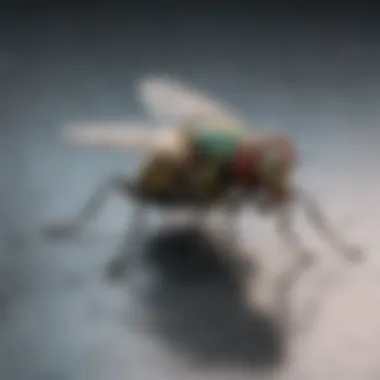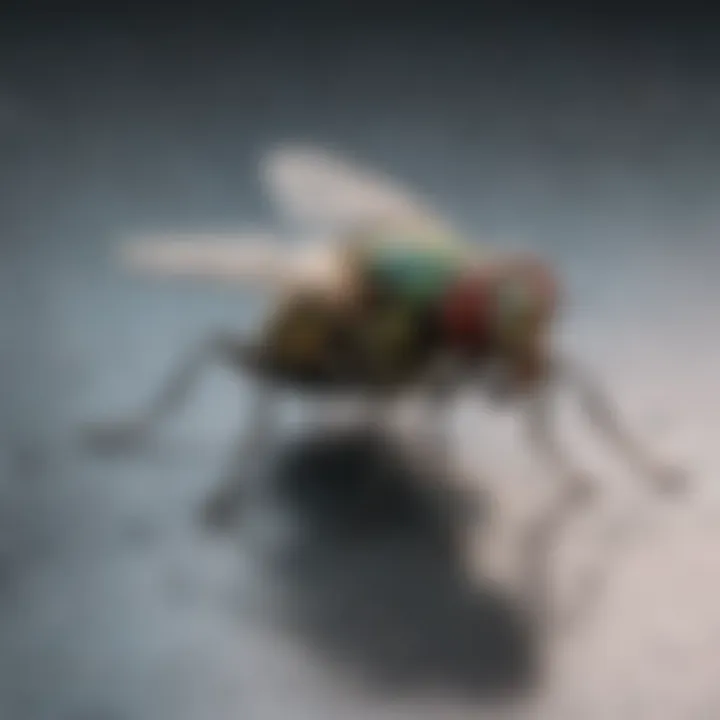Understanding the Sudden Influx of Flies in Your Home


Intro
The presence of flies in the home can be bothersome. At times, homeowners find themselves facing an unexpected surge of these pests. Understanding why this occurs is essential for effective management and prevention. Flies are not just an inconvenience; they can pose health risks, contaminating food and spreading diseases.
Identifying the specific types of flies that invade your space provides vital insights. Each species has different behaviors and requirements. Recognizing their patterns is key to addressing an infestation.
Homeowners, gardeners, and anyone hosting gatherings should be aware of the surrounding factors that may attract flies. In this guide, various strategies for prevention and elimination will be discussed. The aim is to provide practical advice that empowers readers to maintain a clean and fly-free environment.
Understanding the sudden influx of flies involves looking at household practices, environmental influences, and the proactive steps that can be taken. This article will clarify these aspects and offer valuable tips.
Foreword
The presence of flies in your home can be an unsettling experience. Understanding why they appear suddenly is critical for any homeowner. This topic is relevant not only from a pest management standpoint, but also for maintaining a healthy living environment.
Flies can carry diseases and compromise the hygiene of your household. By comprehending the dynamics of their influx, you can implement practical steps to deter them. This article elaborates on the pattern of fly behavior, their breeding habits, and the specific conditions that invite them indoors.
Overview of the Fly Problem
Flies are often seen as a nuisance. They multiply quickly and can invade your space without warning. A sudden influx of flies usually indicates that certain conditions have aligned in a way that is favorable to their life cycle. For example, during warmer months, flies reproduce rapidly. House flies and fruit flies are the most common offenders.
Understanding where these flies come from and what attracts them is vital. Sources like exposed food, garbage bins, and even pet waste can draw them to your home. If ignored, these flying pests can create significant discomfort.
Understanding Fly Behavior
To effectively manage a fly problem, it is essential to grasp fly behavior. Flies are naturally drawn to odor, especially decaying matter. This attraction significantly influences their movements and breeding habits. For instance, female house flies can lay hundreds of eggs at a time in suitable environments, such as organic waste.
Their lifecycle progresses quickly from egg to adult, taking roughly a week under ideal conditions. This rapid reproduction means that what starts as a few flies can quickly escalate into a larger infestation. Thus, understanding their behavior helps in both prevention and management strategies.
Flies are also highly mobile and can access your home through minuscule openings. They often enter via open windows or doors, seeking food and breeding sites. By recognizing these behavioral traits, homeowners can strategize effectively to prevent an invasion.
Types of Flies Commonly Found Indoors
Understanding the various types of flies that can invade your home is crucial in managing any potential infestation. Different flies exhibit unique behaviors, breeding habits, and considerations that influence how effectively they can be controlled. Recognizing these differences allows homeowners to tailor their prevention and elimination strategies accordingly. Moreover, knowing which flies are prevalent indoors enables more informed decisions regarding sanitation and pest control measures.
House Flies
House flies, scientifically known as Musca domestica, are among the most common indoor pests. They are typically gray and about 1/8 to 1/4 inch in length. These flies are attracted to decaying organic matter, including food waste and garbage. Their presence indicates potential hygiene issues within the home. House flies are prolific breeders, with a single female capable of laying hundreds of eggs, which can hatch in as little as 24 hours under optimal conditions.
The transmission of diseases is a significant concern with house flies. They can carry bacteria such as Salmonella and E. coli, which can contaminate food and surfaces. Therefore, their prompt removal is important for maintaining a healthy living environment. To deter house flies, it is essential to eliminate any sources of attraction, such as unsealed food items or overflowing trash bins.
Fruit Flies
Fruit flies, known as Drosophila melanogaster, are small, often no more than 1/8 inch long and are easily recognized by their tan color and red eyes. Unlike house flies, their name derives from their preference for ripening or fermenting fruits and vegetables. They are most visible in the kitchen, especially when fruits are left exposed. Fruit flies can reproduce rapidly; a single female may lay over 500 eggs, leading to quick infestations.
Managing fruit flies involves both cleanliness and vigilant monitoring. Ensure that all produce is washed and stored properly. Disposing of overripe fruits promptly helps to cut off their breeding opportunities. Traps, such as apple cider vinegar bowls covered with plastic wrap, can also be effectively used to capture adult fruit flies, allowing for better control.
Drain Flies
Also referred to as moth flies, drain flies (Psychoda spp.) are small, dark-colored insects that thrive in moist environments. They measure about 1/8 inch long and have fuzzy wings that give them a moth-like appearance. Commonly found in bathrooms and kitchens, drain flies breed in stagnant water, particularly in clogged sinks or overlooked drains.
Eliminating drain flies requires addressing the sources of moisture. Cleaning drains and removing organic debris that provides breeding sites are essential. Using a mixture of baking soda and vinegar can help clean stubborn areas in drains. If the infestation persists, evaluating plumbing for leaks or accumulation of debris can provide long-term solutions.
Other Common Indoor Flies
In addition to house flies, fruit flies, and drain flies, other noteworthy indoor flies can pose challenges. This group includes phorid flies, which are small and often found in areas with decaying organic matter, and cluster flies, attracted to windows and unable to escape. Fungus gnats, primarily a concern for indoor plants, can indicate overwatering issues and poor drainage.
To manage these various types of indoor flies, maintaining cleanliness and focusing on sanitation are paramount. Regular cleaning and monitoring can help identify potential breeding grounds before infestations occur. Understanding the habits and preferences of different fly species ultimately provides a better defense within household spaces.
"Adopting a proactive approach in identifying and managing fly populations can significantly reduce their impact on home environments."
By being vigilant and informed, the problem of flies indoors can be minimized, ensuring a more pleasant living space.
Causes of a Sudden Fly Invasion
Understanding the reasons behind a sudden fly invasion is crucial for any homeowner. Flies can be more than just a nuisance; they can constitute health risks by spreading diseases. Identifying the causes can help in taking preventive measures effectively. By recognizing the environmental, behavioral, and structural factors that contribute to fly infestations, homeowners can implement the right strategies to keep these pests at bay.


Environmental Factors
Seasonal Changes
Seasonal changes play a significant role in attracting flies. With the arrival of spring and summer, warmer weather creates an ideal environment for flies to thrive. The key characteristic of these seasons is the increased availability of food sources and breeding sites. Flies are primarily drawn outdoors but will invade homes in search of better conditions. The unique feature of seasonal changes is the ability to influence the population dynamics of flies. As temperatures rise, their numbers can explode, making it essential for homeowners to remain vigilant during these months.
Temperature and Humidity
Temperature and humidity also contribute to the influx of flies. High humidity levels along with warm temperatures provide perfect breeding conditions. Flies not only multiply faster but also become more active during these times. This can lead to rapid infestations inside homes. The notable characteristic here is the relationship between moisture and the attraction of flies to decaying organic matter. Such conditions can allow for increased fly presence, which presents an ongoing challenge for anyone trying to maintain a clean and healthy home.
Attractive Odors and Food Sources
Rotting Foods
Rotting foods are a major draw for flies. Decaying organic matter emits strong odors that lure these pests. The essential characteristic of rotting foods is their high nutrient content, which attracts not just house flies but also fruit flies and others. This makes understanding food storage and waste disposal critical. The unique feature is that even small amounts of organic waste can suffice to attract flies. This gives homeowners a clear disadvantage when dealing with larvae and adult flies.
Unsealed Trash Cans
Trash cans that are not properly sealed can become another magnet for flies. The key characteristic here is the accessibility of waste, which offers abundant food sources. Open or unsealed trash cans contribute to fly infestations significantly, as they allow flies to enter easily and multiply. The unique feature of these trash cans is that even minimal exposure to food waste can lead to substantial fly problems. Homeowners need to ensure their trash bins are tightly closed to mitigate this risk effectively.
Entry Points
Open Windows and Doors
Open windows and doors are common entry points for flies. They can easily enter homes, especially during warmer months. The key characteristic of open entryways is that they provide direct access to indoor environments where flies can find food and breeding sites. This makes it essential for homeowners to monitor their windows and doors, especially when entertaining or during peak fly seasons. The unique feature here is the ease with which flies can invade, often unnoticed until the problem escalates.
Cracks and Crevices
Cracks and crevices in buildings can also facilitate fly entry. Flies are adept at squeezing through tiny openings. The notable characteristic of these structural weaknesses is how unnoticed they can be, allowing a steady flow of pests inside. The unique feature of cracks and crevices is their often overlooked nature, which means homeowners might not even realize they are potential entry points for flies. Regular inspection and maintenance can greatly reduce these risks.
Preventive Measures
Preventive measures are crucial in managing and minimizing the risk of a sudden influx of flies in the home. These strategies focus on proactive steps that can be taken to eliminate conditions conducive to fly infestations. By implementing effective preventive measures, homeowners can create an environment that dissuades flies from entering and thriving inside their spaces.
Maintaining Cleanliness
Keeping a clean home is one of the most effective ways to prevent flies. Flies are attracted to dirt, waste, and decaying matter. Maintaining cleanliness covers various aspects, from regular cleaning routines to proper food storage.
Regular Cleaning Routines
Regular cleaning routines involve scheduled cleaning of indoor spaces. This contributes to the overall goal of reducing fly attraction. A key characteristic of these routines is consistency; cleaning should be part of daily life. Regularly cleaning surfaces, especially in kitchens and dining areas, helps remove food residues and spills that attract flies.
The unique feature of regular cleaning is its dual effect: it not only eliminates potential food sources for flies but also enhances the overall hygiene of the home. The advantages include a fresher living environment and reduced risk of fly infestations. However, it requires commitment and effort from all household members, which might be challenging for some.
Proper Food Storage
Proper food storage is vital in preventing flies. Storing food in airtight containers limits access to flies, who seek out food sources. The key characteristic of proper food storage is that it prevents flies from laying eggs in open food items, which can lead to rapid multiplication.
The unique feature here is the variety of storage options available. Whether using sealing containers or refrigerating perishable goods, the advantages are clear: prolonged food freshness and reduced risk of attracting flies. A disadvantage might be that improper storage habits can easily lead to unforeseen openings where flies can invade, highlighting the importance of consistent practices.
Sealing Entry Points
On top of maintaining cleanliness, sealing entry points in the home is another significant aspect of preventing fly infestations. Flies can enter through various openings, and addressing these vulnerabilities is key.
Use of Screens
Using screens on windows and doors reduces access for flies and other pests. The primary contribution of screens lies in their ability to create a physical barrier while still allowing ventilation. A key characteristic of screens is their visibility; they can be fitted in various styles to blend with home aesthetics.
The unique feature of utilizing screens is their ability to provide airflow without sacrificing protection. This approach is beneficial as it allows homeowners to enjoy fresh air while keeping pests out. However, screens may require regular maintenance and might need replacement if damaged by weather or misuse.
Sealing Cracks
Sealing cracks and crevices prevents flies from finding small entry points into the home. This can be done with caulk and weather-stripping. The specific aspect of sealing cracks is that it addresses structural vulnerabilities. A significant characteristic is its permanent effect, reducing the likelihood of future entry points.
The unique feature of sealing cracks is the thoroughness; it provides long-term protection against not just flies but various pests. Advantages include improved energy efficiency and a more structured home environment. Disadvantages may include the need for initial labor and potential costs involved in full inspection and repairs.


Using Natural Repellents
Natural repellents offer an eco-friendly approach to preventing flies. They serve as deterrents without relying on harsh chemicals, aligning with a growing trend for more sustainable pest management strategies.
Essential Oils
Essential oils, like peppermint and eucalyptus, can repel flies effectively. Their contribution lies in their aromatic properties, which flies tend to avoid. A key characteristic of essential oils is their versatility; they can be used in spray bottles or diffusers.
The unique feature is their natural composition, appealing to homeowners concerned about chemical use. Advantages include pleasant scents and a lower risk of toxicity for pets. However, they may require frequent application to maintain effectiveness, which can be a drawback for some.
Plant-Based Deterrents
Plant-based deterrents involve using specific plants that inherently repel flies. Examples include basil and lavender, known for their fragrant properties. Their contribution to the overall topic is in creating a natural barrier against pests. A vital characteristic of plant-based deterrents is their dual function as decorative elements in gardens or homes.
The unique aspect is their sustainability; using living plants can enhance aesthetics while providing pest control. Advantages include minimal environmental impact, although they may need care and attention like any plant, which might not suit every home environment.
Identifying Infestation Signs
Identifying infestation signs is crucial for understanding and addressing the potential for a fly problem in your home. Early detection can facilitate prompt action to mitigate the issue. Two major components of identifying fly infestations are visual clues and behavioral indicators. These signs can help you determine the extent of the problem and guide your response strategies effectively. The sooner you can identify these signs, the better prepared you'll be to combat an unwanted invasion of flies.
Visual Clues
Visual clues involve tangible evidence that indicates the presence of flies or their breeding grounds in your living space. These might include spots where flies gather, as well as remnants of their life cycle.
Presence of Eggs
The presence of eggs in your home is an alarming but important visual indication of infestation. House flies, fruit flies, and others typically lay their eggs in damp areas near food sources. Each female fly can lay hundreds of eggs at a time, leading to rapid population growth.
The key characteristic of fly eggs is their small size, often about 1 millimeter long, and they appear as tiny, white, or translucent structures, usually found in clusters. Recognizing the presence of eggs can be beneficial for your overall pest management strategy. By locating and removing these eggs early, you can potentially stop a larger infestation before it starts.
However, a disadvantage is that eggs might be hidden in less accessible locations, making them harder to find without a thorough inspection. This can sometimes lead to underestimating the potential problem in your home.
Accumulation of Fly Debris
Accumulation of fly debris is another significant visual clue that reflects an ongoing infestation. This can include droppings or remnants of fly bodies near food or waste sources. Such debris is often dark in color and can appear like small specks or stains.
The key characteristic of this debris is that it often indicates a specific area where flies frequent, which could be crucial for targeting your cleaning efforts. Observing these signs can lead to more effective prevention strategies by enabling you to identify problem areas early.
On the downside, relying solely on debris could lead to missed signs if you do not look closely. Observing accumulation takes time and attention to detail, which may be overlooked in busy daily life.
Behavioral Indicators
Behavioral indicators provide insight into fly activity and help discern the severity of an infestation without direct visual evidence. Noticing certain behaviors can signal that immediate action is required to restore your home to a fly-free environment.
Unusual Swarming
Unusual swarming is a primary behavioral indicator of fly activity. When flies gather in groups, it signals a nearby food source or breeding ground. The key characteristic of this swarming is often the number of flies present; a small group can indicate a mild issue, while large swarms suggest a serious infestation. Observing swarming behavior is beneficial because it can direct focus to specific areas in your home, helping to locate problems more effectively.
Unfortunately, swarming is often a fleeting behavior. Flies may appear and disappear quickly, making it challenging to pinpoint the precise source of the problem. This requires vigilance and attentiveness to catch the behavior consistently.
Frequent Sightings
Frequent sightings of flies indoors is another significant behavioral indicator. If you notice consistent appearances of flies in your home throughout the day, particularly near food or waste, this may reflect an underlying infestation issue.
The key characteristic of frequent sightings is the recurring nature of encountering flies. Unlike occasional appearances, frequent fly activity suggests a stable breeding or feeding ground nearby. This can be very beneficial in identifying areas that need immediate attention to help reduce their numbers.
However, it is essential to consider that the presence of a few flies does not always indicate a severe infestation. There can be instances of isolated flies entering your home for legitimate reasons, such as open doors or windows. Therefore, context is essential when interpreting frequent sightings.
Effective Elimination Techniques
The significance of effective elimination techniques cannot be overstated when dealing with a sudden influx of flies in your home. Understanding that flies reproduce rapidly is crucial. An effective response minimizes their numbers and prevents them from becoming a persistent problem. The methodology requires selecting the right approach according to your situation, balancing practicality and human considerations. A blend of physical trapping methods and chemical controls can yield optimal results, adapting to the scale of the infestation and your environmental values.
Traps and Pesticides
Commercial Solutions


Commercial solutions for fly control are widely available and convenient. These products typically include insect sprays, fly baits, and sticky traps. The key characteristic of these solutions is their ability to act quickly against adult flies. Many consumers find this immediate effectiveness appealing, especially when urgency is a concern. Products like Raid® Fly Spray or Hot Shot® Fly Trap are noted for their formulations that target common indoor flies.
However, there are advantages and disadvantages to consider. While commercial solutions often provide quick results, they can contain chemicals that may pose risks to pets or young children. The unique feature of these products is their targeted action, often resulting in a noticeable reduction in fly numbers within hours. Still, the reliance on chemical solutions may not align with every homeowner's preferences for an eco-friendly approach.
Homemade Traps
In contrast, homemade traps offer a natural solution to fly issues and have grown in popularity due to their ease of creation using common household items. These traps can range from apple cider vinegar traps to soap and water mixtures. The primary appeal lies in their safety and cost-effectiveness. Utilizing items found in the kitchen, such as vinegar and a jar, allows homeowners to tackle fly problems without professional assistance.
Homemade traps are beneficial as they do not pose the same chemical risks that commercial products might. The distinctive feature of these traps is their non-toxic nature and the ability for users to customize them. While these traps can effectively reduce fly populations, their limitations include a slower action time, which may not be ideal for larger infestations.
Professional Pest Control
Choosing a Pest Control Service
When an infestation becomes overwhelming, selecting a pest control service can be the best course of action. This option offers a specialized approach to fly elimination, rooted in professional knowledge and equipment. The key characteristic of this route is the comprehensive assessment and tailored solutions provided by trained experts.
The unique advantage of professional pest control services lies in their ability to address underlying issues contributing to fly populations, not just the visible symptoms. However, reliance on a service may bring concerns regarding trustworthiness and effectiveness, so thoroughly researching reputable companies is essential prior to committing.
Cost Considerations
When deciding on pest control options, cost considerations become an integral part of the evaluation. Professional services vary widely in price depending on factors such as location, severity of the infestation, and service frequency. The key characteristic is their potential for long-term solutions, helping to eradicate flies entirely.
However, understanding the cost can be a double-edged sword. On one hand, hiring a professional may seem like a steep investment, especially for homeowners on a budget. On the other hand, the long-term benefits of eradicating flies may justify the expense over time, as it prevents future infestations that would require further intervention.
Effective strategies combine multiple approaches, adapting methods to the specific needs of a home to create a fly-free environment.
Attracting Beneficial Insects
Attracting beneficial insects plays a crucial role in managing pest populations, including flies. These insects offer natural avenues to control unwanted flies in and around the home. By fostering an environment that attracts these beneficial species, homeowners can enhance their ecological balance, leading to less reliance on chemical interventions. This approach not only promotes a healthier living space but also contributes positively to the surrounding ecosystem.
Understanding Ecological Balance
Ecological balance involves the interaction and interdependence of various organisms within an ecosystem. When beneficial insects are present, they can reduce the number of pests, including problematic flies. For example, predatory insects such as wasps and ladybugs feed on other pests that might create issues in a household. Understanding these dynamics helps homeowners foster habitats for these beneficial insects.
For optimal results, setting up diverse plant species that attract these insects is essential. By maintaining a variety of plants, it lends to a broader spectrum of beneficial insects in the area. This balance ensures that any sudden influx of flies does not become an overwhelming problem, as their populations are kept in check by natural predators.
Using Companion Planting
Companion planting is an effective technique that involves growing certain plants in proximity for mutual benefits. This practice can deter pests, including flies, while attracting beneficial insects that further assist in pest control.
Plants that Deter Flies
Several plants are known for their ability to deter flies. For instance, basil is commonly recognized as a natural repellent against house flies. Its aroma is unpleasant to flies, making it an excellent choice for preventing their presence. Additionally, marigolds release compounds that can repel various pests as well.
The key characteristic of these plants is their strong fragrances, which are often off-putting to flies. They serve as an effective, organic solution, enhancing both aesthetics and pest management. Another advantage is that they require minimal upkeep. However, it is worth noting that reliance solely on these plants may not completely eliminate flies, but they can certainly reduce their population significantly.
Beneficial Insect Species
Beneficial insect species, such as lacewings and hoverflies, are vital for controlling pest populations. Lacewings are particularly effective as their larvae consume aphids and other soft-bodied insects that can also attract flies. Hoverflies mimic bees and not only aid in pollination but also have hungry larvae that feast on aphids and thrips, further maintaining a balanced environment.
These species are a popular choice for promoting a fly-free home. Their unique feature lies in their dual role as pollinators and pest controllers. By attracting these insects, homeowners can effectively reduce fly populations naturally. However, homeowners must ensure a biodiverse environment to support these species throughout the growing season. This approach leads to better long-term management of fly populations with fewer chemicals.
Finale
Summary of Key Points
This article has covered various aspects of dealing with fly invasions. We explored the types of flies commonly found indoors, including house flies, fruit flies, and drain flies. Each type possesses distinct behaviors and habits that affect their attraction to our living spaces.
Environmental factors often trigger these invasions. Seasonal changes can alter the population, while temperature and humidity levels can create more favorable conditions for flies. We discussed how attractive odors and unsealed trash cans act as invitations for these pests, alongside the impact of open windows and cracks in the walls as entry points.
Preventive measures, including maintaining cleanliness and sealing entry points, play critical roles in a fly-free home. Adding natural repellents can also help. We further examined effective elimination techniques, such as traps and pesticides, and considered the option of hiring a professional pest control service.
Lastly, we highlighted the benefits of attracting beneficial insects, which can aid in ecological balance and control fly populations naturally.
Final Thoughts on Fly Management
Managing flies is an ongoing process. Homeowners should focus on creating a proactive strategy. By maintaining cleanliness and being aware of environmental factors, you can significantly reduce the chances of fly invasions.
Utilizing effective elimination techniques promptly can stop an infestation in its tracks. Additionally, encouraging beneficial insects through companion planting may offer a long-term solution to the fly problem.
Ultimately, understanding flies involves both immediate actions and long-term strategies. With awareness and diligence, a fly-free home can be achieved. This comprehensive understanding allows homeowners to manage their spaces best, ensuring comfort and hygiene.















